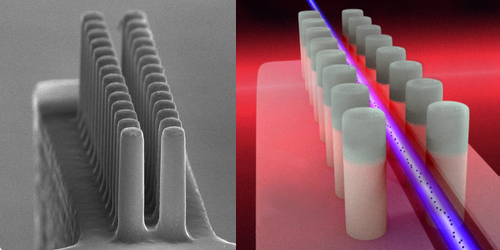A Lens for Millimeter-Sized Electron Accelerators
The SLAC National Accelerator Laboratory in California houses one of the world’s shortest particle accelerators. At just a few millimeters long, so-called “on-chip” accelerators could significantly reduce the costs and infrastructure needs of future particle colliders. However, current chip accelerators require conventional particle accelerators to first rev up electrons to nearly the speed of light—the chip then gives the final speed boost. Now Dylan Black at Stanford University, Calfornia, and colleagues have taken a step toward stand-alone chip accelerators, demonstrating a micrometer-sized lens that could be incorporated into such a device. Such a lens will be essential for future chip accelerators if they are to keep slow electrons confined as the particles are pushed to high speeds.
The lens developed by Black and colleagues consists of two rows of 15 silicon pillars. The electron beam travels between the two rows down a 375-nm-wide channel. To activate the lens, the team hits the pillars with a femtosecond-pulsed laser. The laser pulses generate a large, oscillating electromagnetic field between the pillar rows, which pushes the electrons toward the channel’s center, focusing and confining the particles in a narrow beam.
The team achieved a focusing power equivalent to that of plasma-based lenses—an alternative but undesirable lens option that is much less stable. They also tuned the lens’ power by adjusting the strength of the laser pulses. The team has yet to incorporate the lens into a chip accelerator. But they say that step should be relatively easy—similar pillar structures already exist in these devices, where the electric field they generate is used to accelerate the electrons.
This research is published in Physical Review Letters.
–Katherine Wright
Katherine Wright is a Senior Editor of Physics.





